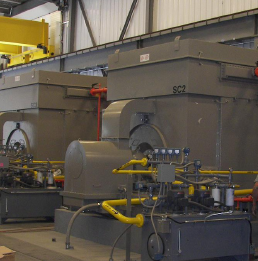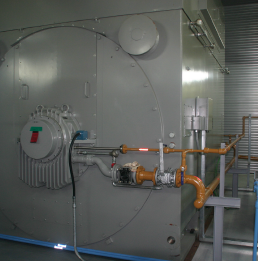Home  Systems & Services Systems & Services  FACTS FACTS  Synchronous Condenser Synchronous Condenser
|
||
|
Today’s Challenging Environment
For most utilities ensuring grid reliability, efficiency, and security is a primary concern. As the grid evolves and load profiles change, stresses are being put onto transmission and distribution networks, making the work of grid management much more challenging. Globally, utilities are facing many grid challenges and market condition changes including:
These challenges have an operational impact on the electrical infrastructure, in particular creating an overall deficiency in:
GE’s Solution GE offers transmission utilities a simple and reliable solution to address reactive compensation and voltage support requirements. Our newly re-designed motor based Synchronous Condensers are custom designed to provide transmission operators with a proven, robust and reliable solution.
|
|||||||||||||||||
|
The GE Advantage
GE’s Synchronous Condenser Systems are engineered and designed to provide a highly reliable and efficient solution, providing an optimized solution for cost, performance and operational flexibility.
Modular design resulting in operational flexibility and decreased down time
Robust design with extended life resulting in minimal maintenance
Customized design and use of innovate technology resulting in increased reliability and reduced risk of failure
Extensive experience resulting in seamless integration into the utility transmission grid GE leads the industry with more than 100 years of experience and the proven synchronous condenser design has been applied in over 200 applications. |
|||
|
Key Benefits of GE’s Synchronous Condensers
Installation & Maintenance Benefits
|
|||||||||||||||||||||||||||||||||
|
Core Components
GE’s Synchronous Condenser system consists of components commonly used in electric utilities and industrial facilities, with proven robustness and reliability.
|
|||
|
Integrated Intelligent Controls |
Integrated Intelligent Controls | |||
 |
Control Systems & Protection Relays
|
 |
Power Delivery Equipment
|
|
|
Typical Applications
|
||||||||||||
|
Customer Case Studies
|
|||
 Customer Name Vermont Electric Company (VELCO) Location Granite Substation, Vermont, USA Application / Challenge: As part of the Northwest Vermont Reliability Project a number of upgrades were investigated to provide for the reactive power needs at the Granite substation. Simulations indicated that the power system is very near a point of voltage instability. In the case of an outage of the Vermont Yankee – Coolidge 345kV line, a continuous reactive power control device is critical to prevent voltage collapse. Solution:
|

Customer Name Korea Electric Power Company (KEPCO) Location Jeju Converter Station Jeju Island, Korea Application / Challenge: The function of a synchronous condenser system in a weak AC grid, and especially one that connects via an HVDC converter terminal, is to improve short circuit strength, provide inertia, and improve reliability. Solution: GE supplied two +50/-25 MVAr synchronous condensers to KEPCO that allow the Chejuu-Haenam HVDC link to continue to cost effectively and efficiently provide power to the island. With successful installation of the synchronous condensers, KEPCO will be able to retire their existing, converted gas turbine synchronous condensers and transport more power on the existing grid network. |
||